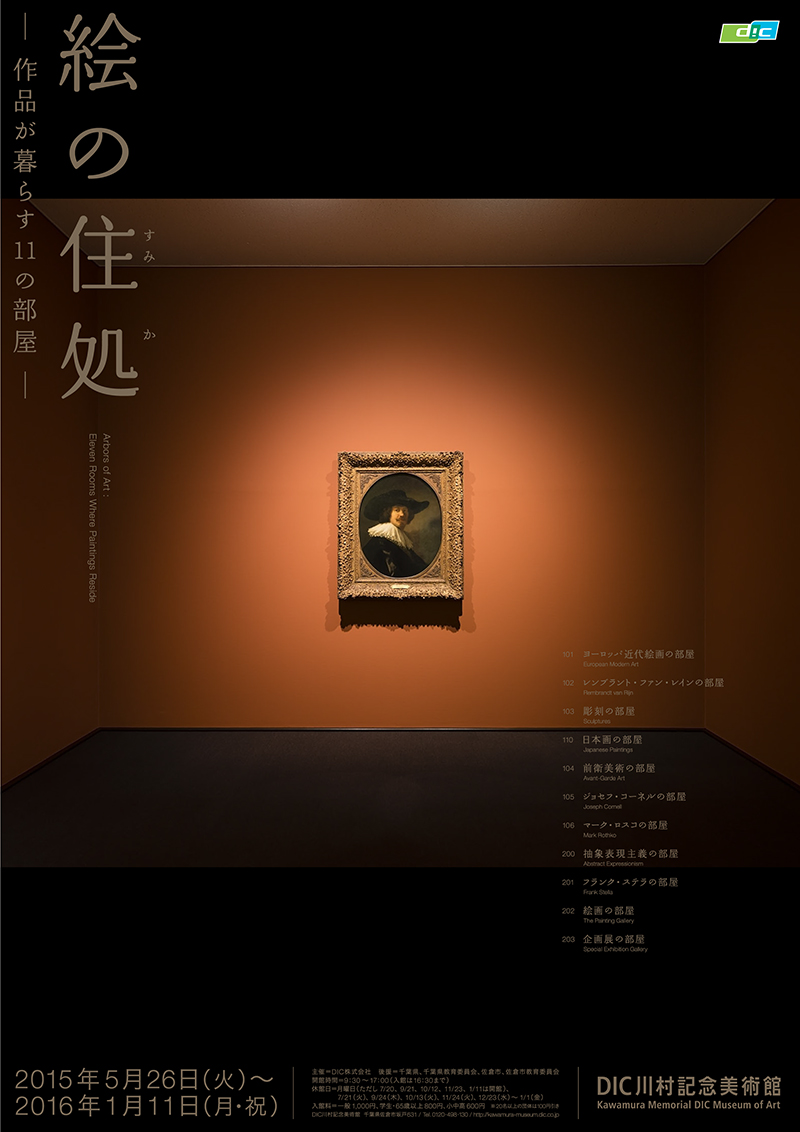Arbors of Art
Eleven Rooms Where Paintings Reside
May 26, 2015 - January 11, 2016
- Hours:
- 9:30-17:00 (last admission 16:30)
- Closed:
- Mondays (except Jul. 20, Sep. 21, Oct. 12, Nov. 23 and Jan. 11), Jul. 21, Sep. 24, Oct. 13, Nov. 24, Dec. 23 - Jan. 1
- Organizer:
- DIC Corporation
- Patrons:
- Chiba Prefecture, Chiba Prefectural Board of Education, Sakura City, Sakura City Board of Education
Museum Admission
- Adults ¥1,000
- College / 65 and over ¥800
- Elem / JH / HS ¥600
Groups of 20 or more:
- Adults ¥900
- College / 65 and over ¥700
- Elem / JH / HS ¥500
Persons with a disability pass:
- Adults ¥800
- College / 65 and over ¥600
- Elem / JH / HS ¥400
*Admission also includes entrance to the permanent collection galleries.
- For students and seniors over 65, discounts require identification such as a Student ID, passport or driver's license.
- For persons with a disability pass=the same discounted price applies for one accompanying care-giver for each disability pass holder
Outline
In the Kawamura Memorial DIC Museum of Art there are eleven galleries, each possessing its own unique atmosphere. This is because each gallery was planned with a size or design intended to best accommodate certain types of works in the museum’s collection.
The gallery for modern European art such as Impressionist paintings has an arched ceiling and the floor is carpeted with the intent of giving it an atmosphere of familiarity like a living room. In the smallest of the museum’s galleries hangs a single painting, a self-portrait of the great 17th century master Rembrandt van Rjin. The gallery for the early 20th century abstract paintings has white walls to create a modern and simple atmosphere, while the gallery for art such as that of the Surrealists and Dada artists is designed in unified grey tones for the floor and walls to give an atmosphere of inward-searching temperament.
The galleries that are intended for showing not the art of such groups but the work of a single artist are designed with greater focus on matching the particular works of the artist. The gallery for showing the large works by Frank Stella in our collection is designed as one giant space with large wall and floor surface areas and wooden flooring and with overhead skylights to let in natural light. The result is a space that enables viewers an experience similar to viewing both early and recent Stella works in the artist’s own studio. Furthermore, the gallery that houses one of the museum’s representative collections, Mark Rothko’s “Seagram Murals” (seven murals in all), is designed in an asymmetrical heptagonal form that allows a separate wall for hanging each of the seven paintings. Also, the corners where the seven walls meet are curved to minimize linear elements and thus create an effect in which the reddish murals themselves appear to be wall sections defining the room.
These effectively “order-made” gallery spaces help bring out the appeal of the art works more fully and create an atmosphere that enables a more relaxed and amiable connection between the works and the viewer. In this exhibition, we hope that visitors will appreciate the subtle nuances of the relationship between the art works and the display spaces as you go from gallery to gallery.
During the exhibitions run there will be a series of gallery talks relating to the works on display and the museum building. This may be an opportunity to find answers to some of the questions about aspects of the museum that have been a mystery to you until now.
